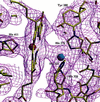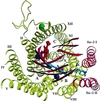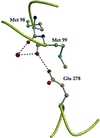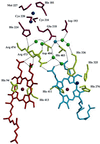Structure at 2.7 A resolution of the Paracoccus denitrificans two-subunit cytochrome c oxidase complexed with an antibody FV fragment
- PMID: 9380672
- PMCID: PMC23397
- DOI: 10.1073/pnas.94.20.10547
Structure at 2.7 A resolution of the Paracoccus denitrificans two-subunit cytochrome c oxidase complexed with an antibody FV fragment
Abstract
The aa3 type cytochrome c oxidase consisting of the core subunits I and II only was isolated from the soil bacterium Paracoccus denitrificans and crystallized as complex with a monoclonal antibody Fv fragment. Crystals could be grown in the presence of a number of different nonionic detergents. However, only undecyl-beta-D-maltoside and cyclohexyl-hexyl-beta-D-maltoside yielded well-ordered crystals suitable for high resolution x-ray crystallographic studies. The crystals belong to space group P212121 and diffract x-rays to at least 2.5 A (1 A = 0.1 nm) resolution using synchrotron radiation. The structure was determined to a resolution of 2.7 A using molecular replacement and refined to a crystallographic R-factor of 20.5% (Rfree = 25.9%). The refined model includes subunits I and II and the 2 chains of the Fv fragment, 2 heme A molecules, 3 copper atoms, and 1 Mg/Mn atom, a new metal (Ca) binding site, 52 tentatively identified water molecules, and 9 detergent molecules. Only four of the water molecules are located in the cytoplasmic half of cytochrome c oxidase. Most of them are near the interface of subunits I and II. Several waters form a hydrogen-bonded cluster, including the heme propionates and the Mg/Mn binding site. The Fv fragment binds to the periplasmic polar domain of subunit II and is critically involved in the formation of the crystal lattice. The crystallization procedure is well reproducible and will allow for the analysis of the structures of mechanistically interesting mutant cytochrome c oxidases.
Figures







References
-
- Saraste M. Q Rev Biophys. 1990;23:331–366. - PubMed
-
- Babcock G T, Wikström M. Nature (London) 1992;356:301–309. - PubMed
-
- Calhoun M W, Thomas J W, Gennis R B. Trends Biochem Sci. 1994;19:325–330. - PubMed
-
- Malatesta F, Antonini G, Sarti P, Brunori M. Biophys Chem. 1995;54:1–33. - PubMed
-
- Ferguson-Miller S, Babcock G T. Chem Rev. 1996;96:2889–2907. - PubMed
Publication types
MeSH terms
Substances
Associated data
- Actions
LinkOut - more resources
Full Text Sources
Other Literature Sources
Molecular Biology Databases

